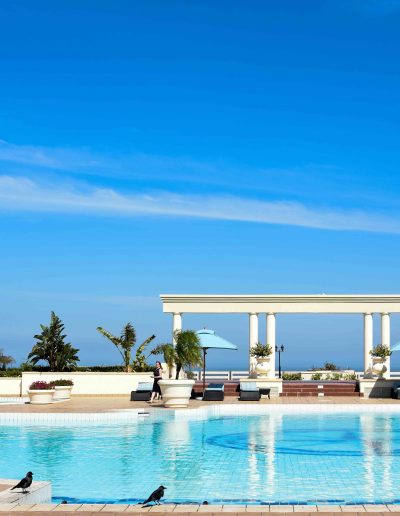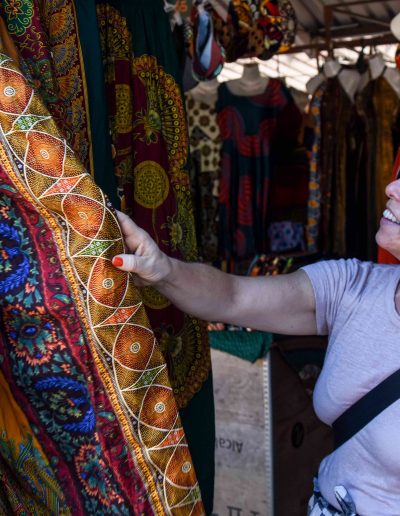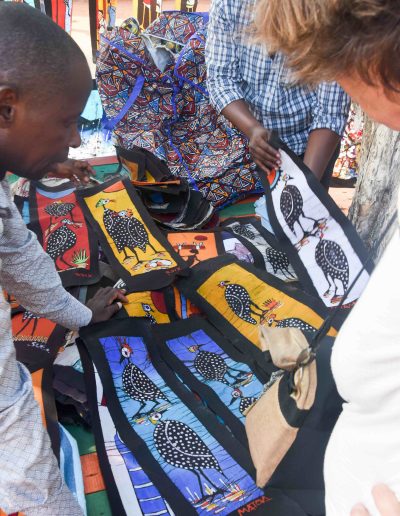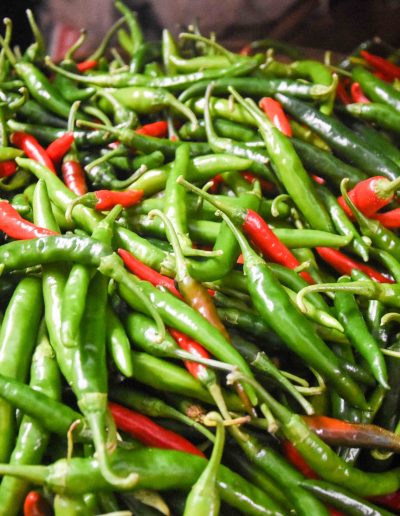Mozambique’s last post, the post about Maputo, the capital. On this trip Maputo was like a place of passage, first on the way to Pemba, then between Ilha de Moçambique and Kruger, with the arrival of Clara, and finally a few days before returning to Lisbon. We were with family, so time in the city had to be split between visiting Maputo’s attractions and spending time with them. So I make a compilation, in order of what we have seen and not in order of importance, of the things there is to do in Maputo.
Polana Neighborhood: Santo António da Polana Church and Hotel Polana
The cousins’ house where we stayed is in the Polana neighborhood, overlooking the church. This was also one of the buildings I longed to visit. Of modernist architecture, it was designed by architect Nuno Craveiro Lopes and built in 1962. It is popularly known as the “orange squeezer” for its peculiar shape, which reminds me so much of the architecture of Oscar Niemeyer. The entrance is through the seminar next door, along Luis Pasteur Street – there is no indication that it is there, just knock on the large garage gate.
Polana Hotel, on the other hand, is a backdrop for my grandparents’ many stories, who used to go to the hotel pool after school. It is the oldest and most luxurious hotel in Maputo, built in 1922, overlooking the bay of Maputo. Here my mother was disappointed with the size of the pool, she imagined it larger. We took the opportunity to order two Txilar beers while we waited for our cousin, and besides not being fresh, they were way too expensive for beer – coincidentally the two places where we were worst served and paid the most was in the hotels Polana and Cardoso. I don’t have many photos of the hotel because at some point I was told it was forbidden to take photos with a professional camera…
FEIMA – Maputo Handicraft, Flowers and Gastronomy Fair
On Mao Tse Tung Avenue with Mártires da Machava Avenue and Armando Tivano Avenue is FEIMA, the most beautiful and complete handicraft market we have seen in the country. Many transformed capulanas, wood and stone scupltures, baskets and bags hanging from the trees, hundreds of batiks and other painted cloths for all tastes. Obviously, as in any country in Africa, prices are not marked and there is room to haggle, which makes us, white tourist-looking, very easy to be fooled – we went to FEIMA on our first day and bought a capulana dress for 1500mts, we came back when my sister arrived and she paid 900mts for the same… Inside FEIMA there is also a flower area, some cafes where you can eat and even a large playground for kids.
Naval Club
In Maputo the climate is a bit uncertain as it is very much influenced by the African winds and in the first two days we were in Maputo we caught a heat wave so that the only way possible to be was inside water! Maputo’s beaches are not ideal for swimming, so we have swimming pools. Almost everyone we meet in Maputo is a member of the Naval Club, of which my grandparents and great-grandparents were also members, and they can take visits with them to the pool during the week. In the Club there are also two restaurants, where anyone can enter, and many children taking swimming lessons. It is on Avenida Marginal.
Railway station
Maputo train station is an important point of connection with neighboring countries and a pearl of colonial architecture. The current building was built between 1913 and 1916, but the apiary has been around since 1895. It’s considered one of the most beautiful railway stations in the world and the most beautiful in Africa – I didn’t find it that great, but ok … Inside the station is located The Railways Museum, but it is closed on Monday, obviously the day we tried to visit it. In front of the station is the Praça dos Trabalhadores, where thousands of people are waiting for the machiombos (buses) or chopelas (vans) and of course all the associated informal commerce.
Maputo Cathedral, Franco-Mozambican Cultural Center, Iron House and Tunduru Garden
In downtown Maputo is where we find most of the city’s tourist attractions. Unfortunately it is also one of the least safe areas of the city and so our family wouldn’t let us go there alone, less with the camera. We almost had to beg to get out of the car and visit the beautiful Maputo Cathedral, next to Independence Square with a large statue of Samora Machel, Mozambique’s first president.
Across the street is the Franco-Mozambican Cultural Center, a fully colonial iron building that houses exhibitions, a handicraft shop, and has concert and performance venues. Below is the Iron House, designed by Gustav Eiffel, a prefabricated building that was relocated from Belgium in 1892 to house the governor’s residence. Here is the entrance to the Tunduru Garden, the city’s botanical garden, which we unfortunately did not visit as there was a mosquito pest in the city after the heavy rains of the previous week, and our cousins thought it would not be advisable…
Municipal Market and Casa Pandia
Once my sister arrived in Mozambique her biggest “ambition” was to go to the market. Finally we went, but the market was not what I imagined, it was much more organized, all sellers in a matching gown and not that mess of Africa. On top of that the market light was terrible for photographs: P we bought peanuts, cashews, fruit and spices and continued through the informal street market in Maputo to Avenida Samuel Mangaia to go to Casa Pandia, a house of capulanas. The most famous is Casa Elefante, just in front of the market, but it was closed. In fact on this street there are several shops that only sell capulanas and also on the street they sell and directly arrange the capulanas. Casa Pandia has all sorts of capulanas and when I say all sorts it’s all sorts: political, religious, with all sorts of patterns and colors, we get lost in the world of capulanas! Tip: take the measurements of the things you want, to know how many capulanas to buy – I just bought one for a tablecloth and it is short by 5cm…
Maputo Fortress
The fortress of Maputo only looks as it is today since 1946. Before being made of stone, it was made of wood and took various forms since this territory was much disputed between Dutch, English, French, Portuguese and probably others. Nowadays it is a kind of museum with paid admission – only one contribution, each one chooses how much to give – where is the equestrian statue of Mouzinho de Albuquerque, which was where now stands the statue of Samora Machel, the remains of Ngungunhane, the last emperor of Gaza, taken prisoner by the same Mouzinho and exiled in the Azores, and still a very interesting exhibition of the history of Mozambique in small wooden sculptures.
Hotel Cardoso Swimming Pool
Another hot day in the city, plus a pool to explore. As we had already been to Hotel Polana and had been told that access should be very expensive, we decided to go to Hotel Cardoso, another luxury hotel from colonial times, overlooking the downtown and the mouth of Maputo river. The entrance to the pool costs 950mts (~14 €) per person and they give us a bracelet that allows us to enter and leave the hotel. Unfortunately we opted to have lunch there by the pool bar as it was more practical, worst dining experience of the whole trip …
Natural History Museum
Opposite the street from Hotel Cardoso is the neo-Manueline building that houses the Natural History Museum. This museum contains a unique collection of elephant fetus, although it is also a testament to an atrocity that occurred during the colonial war: the clearing of wildlife from huge areas. So all the animals we see in the museum are stuffed animals from that time – and obviously the elephant fetuses were taken from their dead pregnant mothers. Although it is quite noticeable that all the pieces of the museum are quite old and already needed a restoration, it is totally worth visiting the museum.
Streets of Maputo
One of the things to explore in Maputo is its informal street markets, exploring the old architecture of what was once colonial times, or seeing the red acacia trees and jacaranda trees in bloom. There is everything for sale on the streets, including services like the sewing we saw before, and many calamidades markets. Calamidades are second-hand clothing markets, the clothes that we donate to be distributed to the poor but are actually sold at super low prices. The truth is that setting up a distribution network requires a lot of money and this is how it is paid at a price that everyone can afford. Another of the phenomena we saw was the Palace of Weddings on a Saturday! So much joy together, several groups singing and dancing while their friends or family signed the wedding papers.
Maputo has some things to see but the truth is that it was the least interesting part of the trip as a life experience. We didn’t eat anything especial except at home when our cousins’ cooks were preparing a meal, we never felt threatened but they never let us explore the city too much because of the lack of security. I was sorry that we did not go to Catembe, the opposite bank of the Maputo river, now so easily reachable with the new bridge, or to Inhaca Island. The only place we went around Maputo was Ponta do Ouro, an experience you can read in another post.
If you liked this post and want to read more about my trip to Mozambique or neighboring South Africa, you can visit the following posts:

































































































